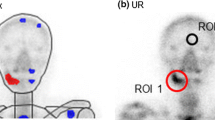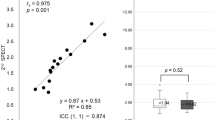Abstract
Objective
The usefulness of bone scan index (BSI), a quantitative metric of the area of uptake in computer-aided diagnosis in bone scintigraphy, has been reported for the diagnosis of anti-resorptive-agent-related osteonecrosis of the jaw (ARONJ). The aim of this study is to validate the diagnostic ability of BSI for the early detection of ARONJ. In addition, the Bone uptake value (BUV), another quantitative index obtained from bone scintigraphy that indicates the degree of radioisotope (RI) accumulation, was used to improve the diagnostic ability for early detection of ARONJ.
Methods
A total of 34 patients (11 with ARONJ, 23 without ARONJ) who were administered anti-resorptive-agents for bone metastasis and had incidentally consulted a dental surgeon within 3 months after regular whole-body bone scintigraphy were retrospectively included in the study. The bone scintigraphy data were subjected to semiquantitative analysis of uptake in the jaw using BONENAVI (FUJIFILM Toyama Chemical, Co. Ltd., Tokyo, Japan; EXINI Diagnostics AB, Lund, Sweden) and BUV software (Technical Society for Quantitative Bone Scintigraphy and Fujifilm Toyama Chemical Co., Ltd. Tokyo, Japan). The ROI was set semi-automatically on mandibular hotspots, and the regional BSI was termed BSIJ. Planar anterior and posterior images were then sent to BUV software, with the ROI set manually as for BSI, and the regional BUV was termed BUVJ.
Results
Mean BSIJ values for the ARONJ positive and ARONJ negative groups were 0.17 ± 0.83 and 0.03 ± 0.50%, respectively. Mean BUVJ values for the ARONJ positive and ARONJ negative groups were 0.47 ± 0.17 and 0.19 ± 0.11, respectively. BSIJ × BUVJ values for the ARONJ positive versus ARONJ negative groups were 0.088 ± 0.067 vs. 0.007 ± 0.010. The AUC for BSIJ, BUVJ and BSIJ × BUVJ was 0.949, 0.951 and 0.988, respectively.
Conclusion
The BSI metric of a CAD system for bone scintigraphy was useful for the early detection of ARONJ. Accuracy was improved with the additional use of BUVJ data. We recommend that SPECT imaging be performed when bone scintigraphy reveals focal or diffuse uptake in the mandible with high BSIJ and BUVJ.




Similar content being viewed by others
References
Ruggiero SL, Dodson TB, Fantasia J, Goodday R, Aghaloo T, Mehrotra B, et al. American association of oral and maxillofacial surgeons position paper on medication-related osteonecrosis of the jaw-2014 update. J Oral Maxillofac Surg. 2014;72:1938–56.
Van den Wyngaert T, Huizing MT, Fossion E, Vermorken JB. Prognostic value of bone scintigraphy in cancer patients with osteonecrosis of the jaw. Clin Nucl Med. 2011;36:17–20.
Zanglis A, Andreopoulos D, Dima M, Baltas G, Baziotis N. Jaw uptake of technetium-99 methylene diphosphonate in patients on biphosphonates: a word of caution. Hell J Nucl Med. 2007;10:177–80.
Dore F, Filippi L, Biasotto M, Chiandussi S, Cavalli F, DiLenarda R. Bone scintigraphy and SPECT/CT of bisphosphonate induced osteonecrosis of the jaw. J Nucl Med. 2009;50:30–5.
Hong CM, Ahn BC, Choi SY, Kim DH, Lee SW, Kwon TG, et al. Implications of three-phase bone scintigraphy for the diagnosis of bisphosphonate-related osteonecrosis of the jaw. Nucl Med Mol Imaging. 2012;46:162–8.
Ohbayashi Y, Nakai F, Iwasaki A, Ogawa T, Yamamoto Y, Nishiyama Y, et al. The utility of bone scintigraphy in the assessment of mandibular metabolism during long-term bisphosphonate administration. Odontology. 2017;105(3):382–90.
Ohbayashi Y, Miyake M, Sawai F, Minami Y, Iwasaki A, Matsui Y. Adjunct teriparatide therapy with monitoring of bone turnover markers and bone scintigraphy for bisphosphonate-related osteonecrosis of the jaw. Oral Surg Oral Med Oral Pathol Oral Radiol. 2013;115:e31–7.
Ristow O, Gerngross C, Schwaiger M, Hohlweg-Majert B, Kehl V, Jansen H, et al. Is bone turnover of jawbone and its possible over suppression by bisphosphonates of etiologic importance in pathogenesis of bisphosphonate-related osteonecrosis? J Oral Maxillofac Surg. 2014;72:903–10.
Ristow O, Gerngross C, Schwaiger M, Hohlweg-Majert B, Ristow M, Koerdt S, et al. Does regular zoledronic acid change the bone turnover of the jaw in men with metastatic prostate cancer: a possible clue to the pathogenesis of bisphosphonate related osteonecrosis of the jaw? J Cancer Res Clin Oncol. 2014;140:487–93.
Ristow O, Gerngross C, Schwaiger M, Hohlweg-Majert B, Kehl V, Jansen H, et al. Effect of antiresorptive drugs on bony turnover in the jaw: denosumab compared with bisphosphonates. Br J Oral Maxillofac Surg. 2014;52:308–13.
Lapa C, Linz C, Bluemel C, Mottok A, Mueller-Richter U, Kuebler A, et al. Three-phase bone scintigraphy for imaging osteoradionecrosis of the jaw. Clin Nucl Med. 2014;39:21–5.
Watanabe S, Nakajima K, Mizokami A, Yaegashi H, Noguchi N, Kawashiri S, et al. Bone scan index of the jaw: a new approach for evaluating early-stage anti-resorptive agents-related osteonecrosis. Ann Nucl Med. 2017;31:201–10.
Erdi YE, Humm JL, Lmbriaco M, Yeung H, Larson SM. Quantitative bone metastases analysis based on image segmentation. J Nucl Med. 1997;38:1401–6.
Mitsui Y, Shiina H, Yamamoto Y, Haramoto M, Arichi N, Yasumoto H, et al. Prediction of survival benefit using an automated bone scan index in patients with castration-resistant prostate cancer. BJU Int. 2012;110:E628–34.
Imbriaco M, Larson SM, Yeung HW, Mawlawi OR, Erdi Y, Venkatraman ES, et al. A new parameter for measuring metastatic bone involvement by prostate cancer the bone scan index. Clin Cancer Res. 1998;4:1765–72.
Dennis ER, Jia X, Mezheritskiy IS, Stephenson RD, Schoder H, Fox JJ, et al. Bone scan index: a quantitative treatment response biomarker for castration-resistant metastatic prostate cancer. J Clin Oncol. 2012;30:519–24.
Brown MS, Chu GH, Kim HJ, Allen-Auerbach M, Poon C, Bridges J, et al. Computer-aided quantitative bone scan assessment of prostate cancer treatment response. Nucl Med Commun. 2012;33:384–94.
Noguchi M, Kikuchi H, Ishibashi M, Noda S. Percentage of the positive area of bone metastasis is an independent predictor of disease death in advanced prostate cancer. Br J Cancer. 2003;88:195–201.
Jiang RF, Zhang L, Cheng B, Huang Z, Li DL, Wang MM, et al. Increased uptake of Tc-99 m-methylene diphosphonate in the jaw. Clin Imaging. 2015;39:1068–72.
Arias JA, Pardo C, Olmos A, Cuadrado ML, Ruibal A. Dental diseases and radionuclide imaging of the jaws. Nucl Med Commun. 2004;25:305–10.
Tow DE, Garcia DA, Jansons D, Sullivan TM, Niederman R. Bone scan in dental diseases. J Nucl Med. 1978;19:845–7.
Van den Wyngaert T, Claeys T, Huizing MT, Vermorken JB, Fossion E. Initial experience with conservative treatment in cancer patients with osteonecrosis of the jaw (ONJ) and predictors of outcome. Ann Oncol. 2009;20:331–6.
Badros A, Terpos E, Katodritou E, Goloubeva O, Kastritis E, Verrou E, et al. Natural history of osteonecrosis of the jaw in patients with multiple myeloma. J Clin Oncol. 2008;20:5904–9.
Acknowledgments
This study was supported by Japan agency of medical research and development (AMED) grant.
Funding
None.
Author information
Authors and Affiliations
Corresponding author
Ethics declarations
Conflicts of interest
No potential conflicts of interest were disclosed.
Additional information
Publisher's Note
Springer Nature remains neutral with regard to jurisdictional claims in published maps and institutional affiliations.
Rights and permissions
About this article
Cite this article
Yamamoto, Y., Mitsunaga, S., Horikawa, A. et al. Quantitative bone scan imaging using BSI and BUV: an approach to evaluate ARONJ early. Ann Nucl Med 34, 74–79 (2020). https://doi.org/10.1007/s12149-019-01417-x
Received:
Accepted:
Published:
Issue Date:
DOI: https://doi.org/10.1007/s12149-019-01417-x




